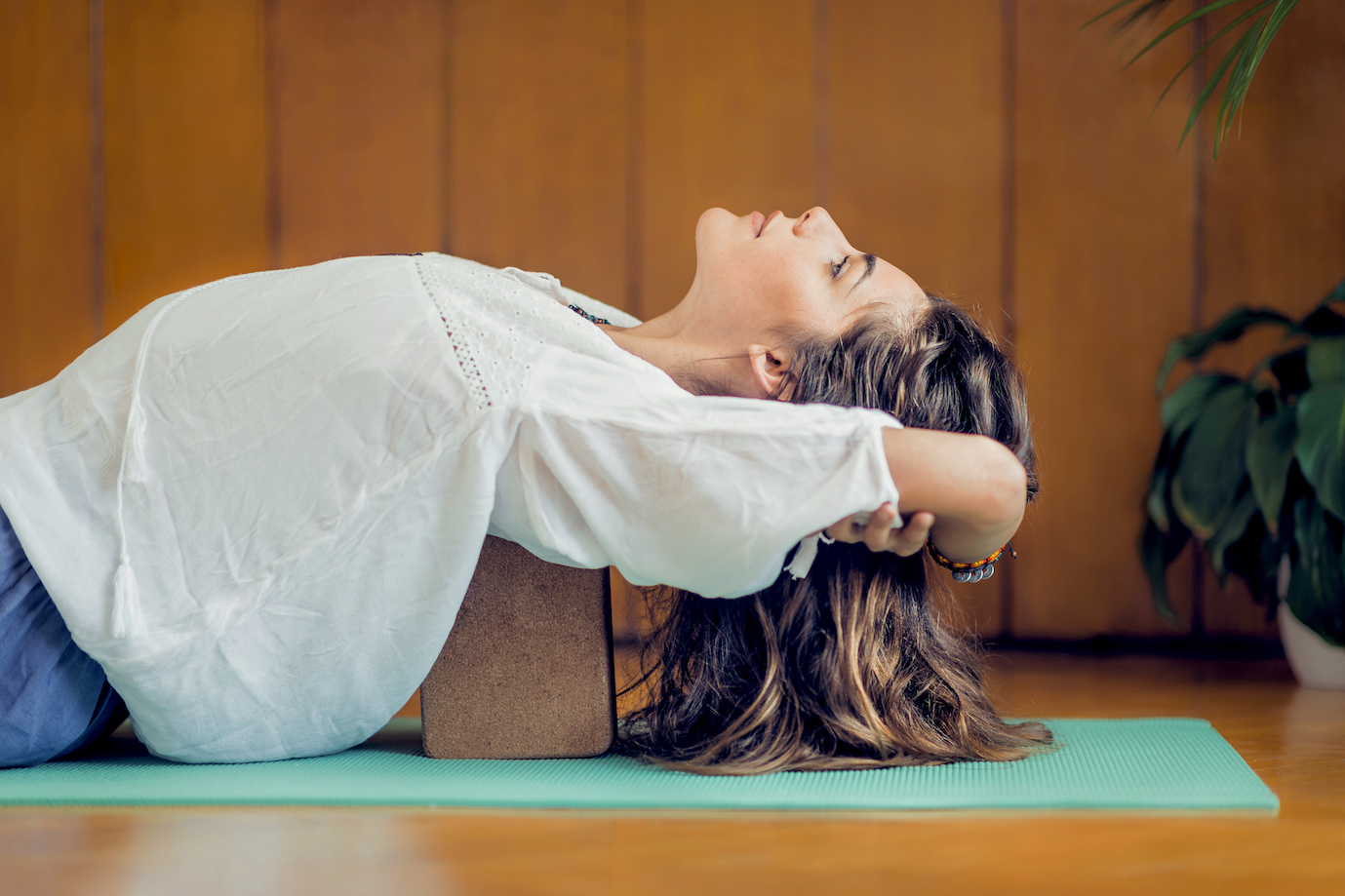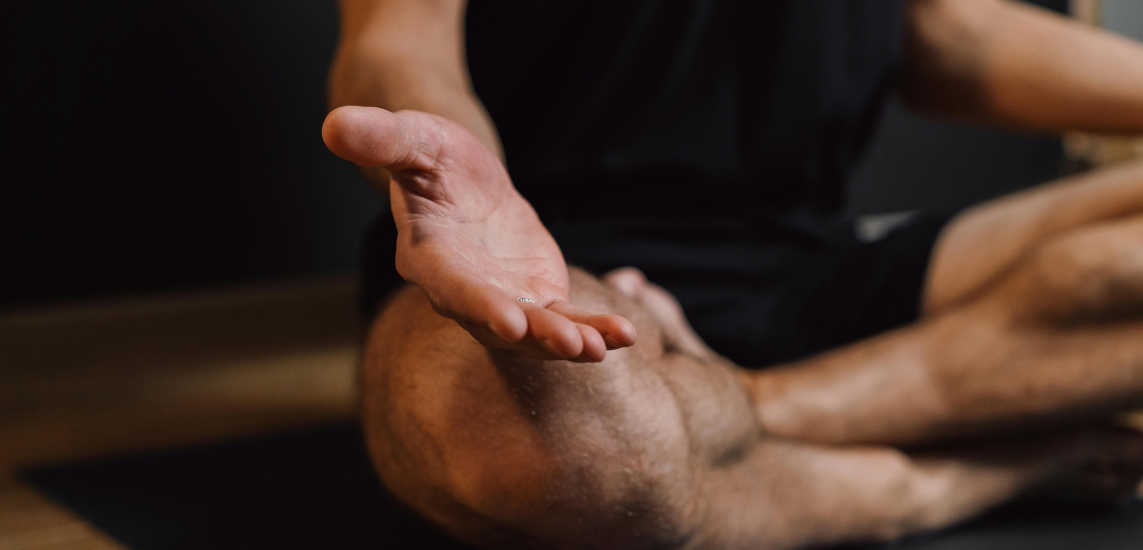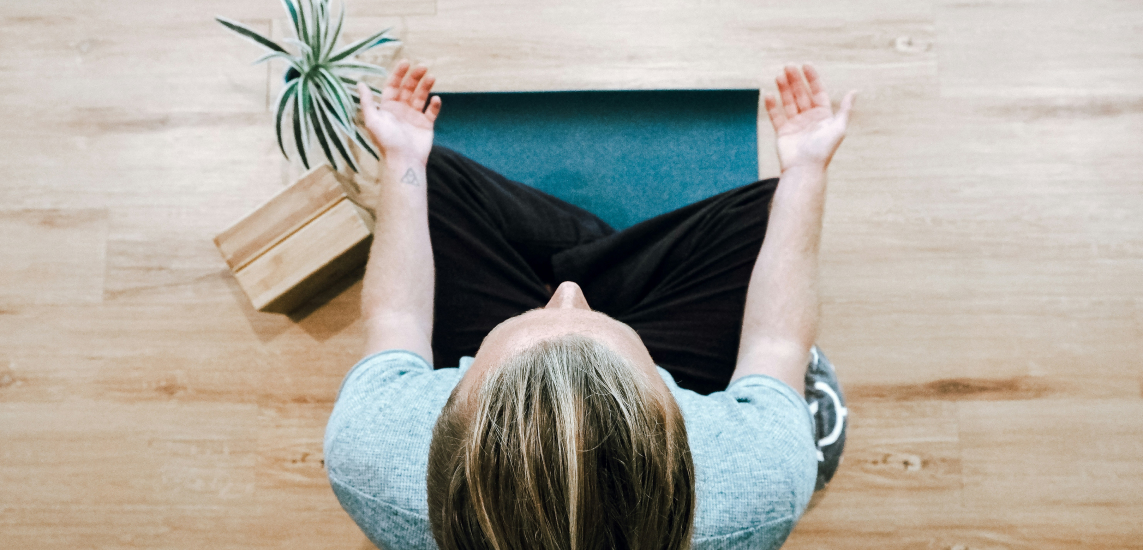Anxiety, pain at their roots have been defined as raw sensations in the body. When we apply mindful awareness through meditation and yoga we are tuning into those raw sensations and helping to heal. Explore how yoga therapy can individually activate self-healing powers to overcome pain, tension and anxiety.
Yoga Therapy: Calming Our Sympathetic Nervous System
The word yoga originated from the Sanskrit word “yuj” which means to “yoke, join or unite.” Yoga brings together our mind, body, and spirit. When one system is out of whack it affects all of our other systems. For example, when we experience pain, our sympathetic nervous system is on “high alert” which can trigger anxiety. Pain and anxiety can perpetuate each other like embers being thrown on a fire. Yoga can help to break the cycle or throw water on the fire by calming the sympathetic nervous system. Simply bringing our attention to our breath — which is an integral part of practicing yoga — can decrease pain and anxiety. Stretching, lengthening, and balancing our muscles during asana practice can help relieve pain, tension, and stiffness that have built up throughout the body.
How Exactly Does Professional Yoga Therapy Relieve Pain, Tension Or Anxiety?
Let’s use an example:
Bob is a 55-year-old attorney. He spends the majority of his day at his desk poring over briefs, talking on the phone, typing on his computer. As a result, his thoracic spine has become more rounded, chest muscles tighter, his head more forward and his hip flexors and hamstrings are increasingly less flexible. He is having tension headaches at the end of the day and finds himself grabbing his low back in pain as soon as he stands up from his desk. His sleep has gotten less restorative and he wakes up in the middle of the night with his mind racing. Bob has also gained some weight over the years around his midsection and one of his goals is to lose some weight. He decides to see a professional yoga therapist following a recommendation from his co-worker.
After performing a thorough evaluation of his strengths, weaknesses, daily habits (including sleep, nutrition, meditation, mindfulness, stress), posture and many more things, his yoga therapist prescribes a personalized home exercise program. Together they decide that she will see him once a week and he will do a program on his own including improving his nutrition in simple ways, increasing his time attempting to sleep, initiating a daily meditation practice to help calm his nervous system down. Bob’s yoga therapist sets small achievable goals and when she sees him once a week they talk about his progress and goals during their session.
What Does Bob’s Yoga Therapy Session Look Like?
They start with a warm-up including some yoga high-intensity interval training (HIIT) for 8 minutes. Then they move on to a standing yoga series including light weights to increase his strength and improve his metabolism, followed by some challenging balance activities and core strengthening.
The last third of the session is devoted to restorative yoga poses with manual therapy. For example, since Bob’s chest is so tight, his professional yoga therapist puts him in the restorative fish pose, lying back on a block lengthwise along his thoracic spine and supporting his head with another block. Blankets are used as needed to increase comfort and allow Bob to completely melt in this pose. His yoga therapist gently gives a little overpressure to his shoulders to further stretch his pectoral muscles and provides some myofascial release to improve that feeling of tightness in the front of his body. She may also do some assisted stretching, traction, deep tissue massage in yoga poses which further relaxes his body and calms his nervous system down.
The cues for breathing are woven throughout the session as Bob is a chest/mouth breather and needs constant reminders to inhale and expand his belly.
Find out how to bring greater awareness to your asana practice and connect with your senses. Also, discover thousands of free guided breathing meditation practices to achieve a sense of calm and peace.
Two Ways Of Using The Breath
The breath is an integral part of yoga. One of my favorite things to teach people is how to take deep abdominal breaths.
- Start by lying down. Place one hand on your belly and one on your chest.
- Now take a deep breath. You will likely feel your chest rise, correct? Chest breathing can perpetuate anxiety by using our accessory muscles.
- Now take a deep breath in and try to feel your belly rise by allowing your belly to float up. Exhale and let your belly fall.
One of my favorite sayings is “when in doubt, breathe out!” The next time you are feeling pain or anxiety try taking three deep mindful abdominal breaths. Using this technique activates your diaphragm, which is the dome-shaped muscle underneath your ribs. Using this muscle helps stimulate your parasympathetic nervous system which has a calming effect. You may be surprised by the power of a simple breath.
Another option when experiencing pain is to send the breath to where it hurts. This may sound cheesy but try it. For example, you might wake up with a sore muscle right underneath your shoulder blade. Close your eyes. Inhale and feel your belly rise, exhale and allow your sore spot to melt. Do you feel your shoulder blade sinking a little further down your back? Do you feel that muscle tightness softening? Whenever pain, soreness or tension bother you throughout the day try sending a mindful breath to that spot.
As someone who has suffered from migraines for 20 years, I know that the breath does not cure chronic pain alone, but it can help you to break the pain/anxiety cycle. Even just 10 minutes a day of simple yoga flow and/or meditation practice can help you break that cycle.
Pause now and listen to these guided meditations by Katie Estridge:
- Mindful Body Scan Katie Estridge 9:54
- Chakra Cleansing Meditation Katie Estridge 8:52
How Professional Yoga Therapy Can Help You
If you are interested in starting an independent yoga practice or improving your current a professional yoga therapist (PYT) is a great place to start. A PYT can give you a yoga program that is specially tailored to your body’s needs and make wellness recommendations to start on or modify your wellness journey. Professional yoga therapy is a methodology for using yoga in healthcare and wellness care as a form of integrative and functional medicine by licensed healthcare professionals. A professional yoga therapist can prescribe yoga according to your specific medical condition.
You can find a PYT here!
Who Else Can Yoga Therapy Help?
I believe most people have issues that yoga therapy can help with. Take Laura for example:
Laura is 39, has three kids and squeezes her part-time work into her children’s brief preschool hours. She is a full-time mom whose husband travels for work most of the week. This leaves no time to herself and she finds herself more and more on edge as the years pass. She also has mild congenital scoliosis causing chronic low back pain and what’s called diastasis rectus abdominis, a condition in which the two sides of the abdominal muscles separate as the tissue connecting them stretches with pregnancy. She has no time to work out and isn’t sure what she can and can’t do. Laura consults a professional yoga therapist to help her decrease her anxiety and get her body back in shape post-kids.
After her evaluation, her therapist comes up with specific quick exercises that she can easily fit into her schedule. She recommends doing yoga and meditation with her older children to help the whole family to improve sleep and decrease stress. Laura’s sessions with the PYT include reviewing her exercises, adding more as needed, a simple yoga flow, manual therapy in restorative yoga poses and a few minutes of meditation. Laura found that her back pain has improved and she isn’t yelling at her kids quite as much.
Read more: Meditation and mindfulness teacher Fleur Chambers how ordinary everyday moments of mindfulness for moms allow mothers to be more present and engaged with the people and things that matter the most.
Identifying Emotions Behind Pain & Tension
If you are feeling pain and/or anxiety, taking some quiet time in yoga or meditation practice and thinking about what emotions may be contributing can be helpful.
I tend to get hormonal migraines about once a month and have for about 20 years. I have figured out how to overcome this by identifying the emotion behind my pain. When I feel a migraine coming, I usually start with meditation and identify the underlying emotions (which are usually overwhelm and stress). I tend to put a lot of pressure on myself.
I like to think of myself as a “recovering perfectionist.” Once I identify those emotions of stress and overwhelm, I soften into these feelings, allowing them to be there. I think to myself “It’s ok that I put pressure on myself. I have a lot going on.” I usually follow this meditation by a simple yoga practice and sometimes a bit of journaling. I make a list of stressors and then reframe things more realistically so that moving forward I can go about my day with a greater sense of lightness.
Read more: The benefits of writing are almost magical. A writing coach explains how journaling/writing can change your life — from becoming smarter to healing wounds.
By tuning into my raw sensations and emotions I can heal my pain and anxiety. I believe that you can, too. We all have the power to heal ourselves. We just need to figure out the best way to tap into our power of self-healing. Meditation, deep breathing and yoga can be that way in.
Reduce your suffering and try meditation for pain. Discover hundreds of free guided practices to manage pain. Or you might want to browse our large library of meditation for anxiety to calm your mind and focus on the present moment.
We put together a playlist of the most popular pain management meditations:
- From Pain To Peace Bethany Auriel-Hagan 15:36
- Journey Through Pain Andy Hobson 13:51
- Breath Based Body Scan Vidyamala Burch 14:32
Read more: Explore how discomfort during your yoga or meditation practice leads to personal and spiritual growth.




-1.jpg)


